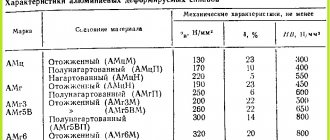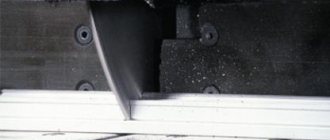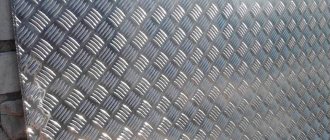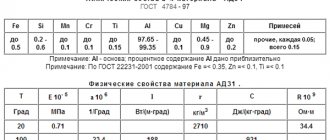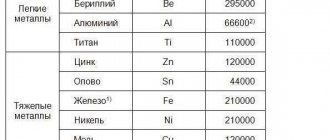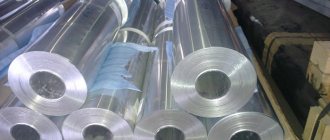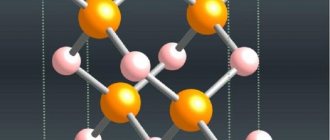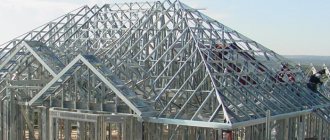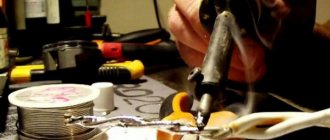Aluminum is a common non-ferrous metal that is actively used in construction and in the manufacture of rolled metal products. A special feature of aluminum is its complete resistance to corrosion, which allows the use of products made from this metal in any construction and metallurgical industry. It is quite light, several times lighter than iron and inferior to the latter in hardness. In order to produce durable rolled metal products or other elements of a building structure, chromium, nickel, bromine or other components with which it fully interacts are added to aluminum.
Marking of aluminum and aluminum alloys
Pure aluminum is marked depending on the content of impurities in it, varies;
- A999 - high purity aluminum;
- A995, A99, A97, A95 - high purity aluminum;
- A85, A8 , ... - aluminum of technical purity.
High purity aluminum is used in the production of semiconductor devices and for research work.
High purity aluminum is used for cladding parts of electrical and radio equipment.
Aluminum of technical purity is used for the preparation of aluminum alloys, the manufacture of wires, gaskets
Technical aluminum is designated by the letters AD (deformable aluminum) , in the case of using purer aluminum the number 1 is given. The combination of the letters AMg and AMts means an alloy of aluminum (A) with magnesium (Mg) and manganese (Mz). For aluminum alloys with magnesium, the number indicates the percentage of magnesium. For example, alloys of the AMgZ, AMg5, AMg6 brands contain 3, 5 and 6% magnesium, respectively.
Alloys in the form of semi-finished products are designated by letters that are placed after the alloy marking: A - means that the alloy is of improved quality, made from the best aluminum; M - soft, annealed; P - semi-coloured (compression degree 40%): N - cold-worked (compression degree 80%). Thus, annealed alloys are designated ADM, AMtsAM, semi-hard-worked alloys - AMgAP and cold-worked alloys - AD1N. AMgZN.
Duralumin is designated by the letter D and a number indicating the conventional number of the alloy, for example alloy D1, D16, D18, D20. Some alloys, developed recently, with the marking B65 VD17 (duralumin coated with a thin layer of pure aluminum to give the alloy corrosion resistance) are called alkled (Alkled is a term, a trademark)
A high-strength alloy of aluminum with zinc and magnesium is designated B94, B95, B96 (the second digit indicates the alloy number).
The condition of semi-finished high-strength alloys and the nature of the plating also have alphanumeric markings: M—soft, annealed; T—heat-treated, hardened and naturally aged. T1 - heat treated, hardened and artificially aged; N - cold-worked (colour-working of duralumin sheets is about 5-7%, and B95-3% alloys); H1—heavily cold-coloured (sheet cold-working is about 20%); B - increased quality of rolling out hardened and aged sheets; O - increased quality of rolling out annealed sheets; B - sheets without cladding or with technological cladding; UP - thickened cladding (8% per side); GK - hot-rolled sheets, slabs; TPP - hardened and aged profiles of increased strength (for D16).
Geometric markings . At the end of the marking for sheet material its thickness in millimeters is indicated, and for profiles - a conventional digital designation of the cross-sectional shape and dimensions. For example, the marking D16ATNVL2.5 means that the clad sheet duralumin D16 is of improved quality, heat-treated, cold-worked and has an improved rolling quality. Sheet thickness 2.5 mm.
Rivet alloys. Alloys used for the production of rivets are marked with the letter P (alloy for wire), for example DZP, D16P.
Aluminum alloys for forging and hot stamping are designated by the letters AK (aluminum forging) and a number - the conventional number of the alloy, for example alloys AK4, AK4-1, AK6, AK6-1, AK8. The additional number -1 shows that the alloy is a close modification of the alloy without the number.
Recently developed forging alloys have non-standard markings, for example alloy D20.
Cast aluminum alloys are designated by the letters AL (aluminum casting) and a number indicating the conventional number of the alloy, for example, AL2, AL4 alloy. AL9, etc. The exception is the new grades of casting alloys VI-11-3, V300, V14-A.
Silumins. Depending on the composition, all aluminum casting alloys are divided into silumins, which are alloys of aluminum and silicon (AL2, AL4, AL9), and alloyed silumins - alloys of aluminum and silicon with the addition of copper (ALZ, AL5, AL9) or magnesium (AL 13, VI-11-3). Altmag - an alloy of aluminum and magnesium (AL8) - and alloys of aluminum and copper (AL7, AL 19) are also used.
Heat treatment modes . For cast aluminum and magnesium alloys, the following designations for heat treatment modes are used: T1—aging; T2 - annealing; T4 - hardening; T5 - hardening and partial aging; T6 - hardening and complete aging to maximum hardness; T7 - hardening and stabilizing tempering; T8 - hardening and softening tempering. For example, the designation AL4T6 shows that the AL4 alloy is subjected to heat treatment according to the T6 regime, consisting of hardening and complete aging.
How winged metal is produced
Metal production can be divided into two stages.
- The first is the extraction of bauxite, its crushing and separation of silicon using steam.
- Second stage : alumina is mixed with molten cryolite and the mixture is exposed to electric current. During the reaction, liquid aluminum settles at the bottom of the bath.
The resulting metal is cast into ingots; then it is sent to consumers or to the production of alloys and high-purity aluminum.
The method is energy-consuming and consumes a lot of electricity.
It can be technical or ultra-clean
The resulting aluminum is called technical or unalloyed. It contains at least 99% pure metal. It is consumed by the electronics industry and is needed in the production of heat exchange and heating devices and lighting equipment.
Some of this metal is sent for additional purification, “refining.” As a result, we have a high-purity metal with an aluminum content of at least 99.995%.
It is used in electronics and in the production of semiconductors. Cable production and chemical engineering now cannot do without ultra-pure aluminum.
Interesting: before the discovery of an industrial method for producing aluminum, it was rare and cost more than gold. Our great chemist, D.I. Mendeleev, the British honored him with a gift. These were analytical balances (an indispensable thing for a chemist), whose cups were made of gold and aluminum.
Metal for wings
Without a metal like aluminum, conquering the sky is impossible. People are not given wings, but man has wanted to fly since ancient times. It is not in vain that the myth of Icarus has lived since ancient times. Attempts to take off were made several times.
But the breakthrough came in 1903, when the Wright brothers, romantics of the sky and wonderful mechanics, took an airplane into the air. This plane opened the way to the sky.
Wrought aluminum alloys
AMts (1.0-1.6% Mn, 0.6% Si 0.7% Fe) has high ductility ( Table 2.7 ) in the annealed state (AMtsM) and low in the cold-worked state (AMtsN), can be welded well by gas, atomic -hydrogen and resistance welding, used for the manufacture of tanks, gasoline and oil pipelines, necks of brackets, pipes and flanges of necks and lightly loaded parts. It is not hardened by heat treatment. Annealing at 350-410° C, cooling in air. Forging and stamping temperature is 420-475° C.
AMg (2.0-2.8% Mg, 0.15-0.40% Mn, 0.4% Si, 0.4 Fe) has the same plastic properties as AMts, and is well welded by atomic-hydrogen and resistance welding , satisfactory - gas. In the annealed state it has unsatisfactory machinability, while in the semi-worked and cold-worked state it has satisfactory machinability. It is used for the manufacture of tanks, gasoline and oil pipelines, walls of inlet pipes, guide cones of plugs and other moderately loaded aircraft parts. It is not hardened by heat treatment. Annealing at 350-410° C, cooling in air. Forging and stamping temperature is 420-275°C.
AMg5P (5.2 Mg, 0.4% MP) has high ductility in the annealed state, is not strengthened by heat treatment, is satisfactorily welded by atomic hydrogen, spot and gas welding, has high corrosion resistance, is supplied in the form of wire, and is used for the manufacture of rivets for riveting structures made of magnesium alloys. Rivets are installed in an annealed state. Annealing temperature 340-410°C with air cooling.
AB (0.2-0.6% Cu, 0.45-0.95% Mg, 0.15-0.35% Mn, 0.5-1.2% Si) has high ductility in the annealed state (AVT ) and medium after hardening and aging (AHT), can be welded well by spot and atomic-hydrogen welding, satisfactorily by gas welding, and is used for the manufacture of parts that require good ductility in the cold and hot state of stamped and forged parts of complex shapes. Forging and stamping temperature 470-475° C
Heat treatment: hardening from 010-525 ° C in water, natural or artificial aging at 150 ° C for 6 hours, annealing at 350-370 ° C, cooling in air (Fig. 2.2 ).
D18P (2.6% Cu, 0.35% Mg) - duralumin with increased ductility.
It is used for the manufacture of rivets, which are installed after hardening and natural aging. Hardening at 490-505° C in water and natural aging for at least 4 days (Fig. 2.3) .
D3P has high ductility in the annealed state; used for the manufacture of rivets, which are placed in a freshly hardened state no later than 3 hours after hardening (D3P alloy is replaced by D18P alloy). Heat treatment: hardening at 490-500°C in water, natural aging for at least 4 days, annealing at 340-370°C, cooling in air.
B65 (4.2% Cu, 0.2% Mg, 0.4% Mn) is an alloy for rivets that are installed in a hardened state and aged, since its ductility is satisfactory and the rivets do not need to be softened by installation. Replaces alloys D1 and D16. Heat treatment: hardening at 510-520° C in water, aging at room temperature for 10 days at a temperature of 50° C for 3 days
D7A alloy for chassis wheel rims, used after hardening and aging.
D1 (4.3% Cu, 0.6% Mg, 0.6% Mn, >=0.7% Si, >=0.7% Fe) has average ductility table. 2.8 Cutting machinability is satisfactory after hardening and aging (D1T) and reduced after annealing. It is used for the manufacture of power elements of medium strength: frame parts, stamped fastening units, screw blades, rivets (the latter are installed in a freshly hardened state no later than 2 hours after hardening). Heat treatment: hardening at 490-510°C in water and natural aging for at least 4 days, annealing at 350-370°C, cooling in air.
D16 (3.8–4.9% Cu, 1.2–1.8 Mg, 0.3–0.9% Mn)—high-strength duralumin. Plasticity in the annealed and freshly hardened state is average, machinability of D16T and D16TN is satisfactory, D16M is reduced. It is used for the manufacture of load-bearing structural elements: frame parts, sheathing, frames, ribs, spars, rivets. When manufacturing heavily loaded parts, it is recommended to replace them with alloy B95. Rivets are placed in a freshly hardened state no later than 20 minutes after hardening. Heat treatment: hardening at 495-505°C in water, natural aging for at least 4 days, annealing at 350-370°C, cooling in air. Annealing of D16TN should be preceded by heating at 450-500° C.
B95 (5-7% Zn, 1.8-2.8% Mg, 1.4-4.0% Cu, 0.2-0.6% Mn, 0.10-0.25% Cr) - high strength aluminum alloy ( Table 2.9 ). Plasticity in the annealed and freshly quenched states is the same as that of the D16 alloy in the same states. In an aged state it is much lower. Cutting machinability and weldability by spot welding are good, while gas welding is unsatisfactory. It is used for the manufacture of structural structural parts: spars, stringers, frames, skins, ribs. Heat treatment; hardening from 465-475°C, cooling in water, artificial aging of clad products at 120°C for 24 hours, unclad ones - at 140°C for 16 hours, annealing at 420°C, cooling in an oven to 150°C and then in the air.
AK4 (1.9-2.5%, Cu, 1.4-1.8% Mg, <=0.2 Mn, 1.0-1.5% Fe, 0.5-1.2% Si, 1.1-1.6% Ni) is a heat-resistant deformable aluminum alloy, has reduced ductility in the hot state, and can be welded satisfactorily by atomic-hydrogen welding. Machinability is satisfactory. It is used for the manufacture of engine parts and other products operating at temperatures up to 350°C. Heat treatment: hardening at 515±5°C, in water, aging at 170°C for 16 hours.
AK4-1 (1.9-2.5% Cu, 1.4-1.8% Mg, <=0.2% Mn, 1.0-1.5% Fe, 1.0-1.5 Ni ) is a heat-resistant wrought alloy. Modifications of AK4 alloy. It has higher (compared to AK-4) strength characteristics, has satisfactory ductility in a hot state, can be welded and processed satisfactorily by cutting. Heat treatment: hardening from 525-535°C, artificial aging at 170°C for 16 hours.
AK6 (1.8-2.6% Cu, 0.4-0.8% Mg, 0.4-0.8% Mn) - high-strength aviation material (Table 2.10), used for the manufacture of stamped and forged parts of complex shape and medium strength: compressor and fan impellers, intakes, diffuser blades and other parts. Heat treatment: hardening at 500-515°C in water and artificial aging at 150-160°C for 12-15 hours.
AK6-1 (2.2% Cu, 0.6% Mg, 0.6% Mn, 0.9% Si, 0.1% Ti, 0.2% Cr) alloy is more ductile than AK6 alloy; used for the manufacture of forged and stamped parts of complex shapes: compressor wheels, impeller intakes and other parts.
AK8 (4.4% Cr, 0.6% Mg, 0.7 Mn, 0.9 Si) is an alloy with high strength but worse than AK6-1. It is processed by hot pressure and therefore can be used for stamping highly loaded aircraft parts of less complex shapes: frames, fittings, etc.
The disadvantage of the alloy, which limits its use for thin-walled parts, is the tendency to intergranular corrosion in an artificially aged state.
Cast aluminum alloys
These alloys are rarely used for repairs, but in aircraft construction alloys AL1 AL2, ALZ, AL4, AL5, AL6, AL7, AL8, AL9, VI-113, AL 19, B300, V14A are used (Table 2.11).
AL4 and AL5 are used for the manufacture of large and medium-sized engine parts subject to significant loads (oil injector housings, flanges, trusses, crankcases, cylinder heads). The disadvantages of alloys include their low heat resistance. Therefore, they are unsuitable for the manufacture of parts operating at temperatures above 200-250 ° C.
ALZ and AL8 with good casting properties, but with average mechanical strength. Used for medium and small parts of engines and equipment that are not subject to significant loads (instrument housings, carburetors, fittings, etc.).
AL7 AL 8, AL9 are used for casting aircraft parts, rocking chair brackets, pedals, etc.
VI-11-3 has high corrosion resistance, good casting properties and increased strength, is hardened by T4 mode, has satisfactory weldability by gas welding and good machinability by cutting, and is used for the manufacture (by earth casting, mold casting or under pressure) of parts with increased corrosion resistance.
AL19 has low corrosion resistance, low casting properties, but high mechanical qualities and heat resistance. Strengthening heat treatment in modes T4 and T5 Well welded and machined by cutting, used for the manufacture of aircraft parts by casting in the ground, operating at temperatures of 175-300 ° C
Sintered aluminum alloys
A deformable heat-resistant alloy from sintered aluminum powder (SAP) is produced by pressing and sintering aluminum powder at 500-600°C
The resulting briquettes are used to make sheets, pipe rods, profiles and other semi-finished products. The density of SAP is 2.7 g/cm3. It welds well, is easy to cut and has high corrosion resistance
SAP is superior in heat resistance to aluminum alloys at 300-500° C and above. This is explained by the presence of aluminum oxide Al 2Oz . With an increase in aluminum oxide in various grades of SAP, the heat resistance increases, and the ductility decreases slightly
Parts made from SAP work for a long time up to 300–550° C and for a short time up to 700–1100° C. SAP is also recommended for use in parts operating in severe corrosive conditions
Sintered aluminum alloys (SAS) are produced by hot briquetting and subsequent pressing at 500°C of mixtures of aluminum powders with other elements.
In SAS 1 add 25-30% Si and 5-7% Ni and in SAS 4 10-15% Si and 17-25% SiC SAS alloys have a low linear expansion coefficient and are used for the manufacture of devices
Alloys SAS D16, SAS V96 have been developed in their properties similar to alloys D16 and V96 but without technological defects associated with casting (oxide and slag inclusions in segregation zones) and pressure treatment (anisotropy of properties)
Composition and properties of sintered alloys and powders SAS 1 contains 6-9% Al2O3 σв=280 N/mm2, δ=5%, σв = 40 N/mm2 at 500°С
SAP2 contains 9 -13% Al2O3 σв=320 N/mm2 δ=4% at 500°С σв = 100 N/mm2,
SAP3 contains 13 -18% Al2O3 σв = 400 N/mm2 δ=3%, at 500°С σв-= 130 N/mm2,
SAP4 contains 18-22% Al2O3> σв = 450 N/mm2, δ = 15% at 500°С σв = 130 N/mm2
Minerals, deposits...and native aluminum?
Aluminum reserves in nature are enormous. Among metals, it holds first place in prevalence. But the “sociability” and activity of the element have led to the fact that the metal is practically absent in its pure form.
Aluminum production in millions of tons
There are many minerals containing aluminum:
- bauxite;
- aluminas;
- feldspars;
- nephelines;
- corundum.
So extracting aluminum raw materials is not difficult.
If all reserves on Earth are depleted (which is doubtful), then aluminum can be extracted from seawater. There its content is 0.01 mg/l.
Anyone who wants to see native aluminum will have to descend into the craters of volcanoes.
The origin of such a metal is from the very depths of our planet.
Aluminum-based composite materials
Composite materials are complex materials that contain insoluble or poorly soluble components that differ greatly in properties. They have high strength, resistance to brittle fracture, heat resistance, elasticity and thermal stability properties. Fibrous and dispersion-strengthened fillers. Based on the shape of the filler, composite materials are divided into fibrous and dispersion-strengthened. The former are strengthened with fibers or thread-like crystals of refractory compounds and elements (Al2O3, SiC C, B, etc.), as well as thin micron tungsten or strong steel wire. The latter are strengthened with fillers made of finely dispersed refractory particles of oxides of carbides, borides, and nitrides
VKA-1 alloy is a composite material based on aluminum and its alloys. The elastic modulus, tensile strength and endurance up to temperatures of 500 C in composite materials are 2-3 times higher than in conventional aluminum alloys
Figure 2.4 shows the dependence of the elastic modulus and tensile strength on the test temperature of the VKA-1 composite material on an aluminum base, strengthened with high-modulus continuous boron fibers, in comparison with the high-strength alloy V95 and the heat-resistant aluminum alloy AK4 1. The VKA-1 alloy contains 50% boron fibers in diameter 100 microns with σв = 2500–3500 N/hm2 and E = 400 kN/mm2, which provides it with σв = 1000–1200 N/mm2 at 20°С, and at 400°С σв = 600 N/mm2 (like an alloy B95 at room temperature). The density of VKA 1 is 2.65 g/cm3, and the specific strength is σb/y = 41, i.e. higher than that of high-strength steels and titanium alloys.
Replacing the V95 alloy in the manufacture of an aircraft wing spar with a titanium alloy with reinforcing elements from the VKA 1 alloy increases its rigidity by 45% and saves weight by about 42%. In addition, dispersion-strengthened alloys do not have anisotropy of properties, like fibrous composite materials.
Source: Handbook of aviation materials and technologies for their use.
Application area
This metal is actively used in the metallurgical, electrical, and mechanical industries. Let's take it in order.
As mentioned earlier, aluminum can be used to make a lightweight metal structure with a high strength coefficient. This is very beneficial in that the costs of foundations for the building, as well as the purchase of durable supports, are eliminated. Another product is very thin hot-rolled sheets, which are actively used in the chemical industry. Due to its inertness to alkalis and other chemicals, aluminum is a priority metal for room cladding.
The second area of application is electrical. It has long been known that aluminum can completely replace copper, as it is an excellent conductor of electricity. Take, for example, electronics in a car. If you replace all copper wires with aluminum, the total weight of the car will decrease by 12 kilograms. This greatly simplifies the task in mechanical engineering. By the way, this metal is often used in mechanical engineering, in the manufacture of small parts for cars and trucks. Thanks to its low weight and high strength, you can significantly reduce the overall weight of the car while maintaining all the performance characteristics.
Mechanical. Each person has his own personal gadget, electronic device or other device. But few people know that every phone contains a small amount of aluminum, which allows it to maintain the functionality of the device, as well as the battery life. Microcircuits, battery contacts - everything is made of this metal.
In addition, it is used in various mechanisms such as a crane or a heavy truck.
It is worth noting that blacksmiths recommend this metal for decorating and cladding buildings. Due to its high malleability, any product can be made from aluminum at minimal cost.
